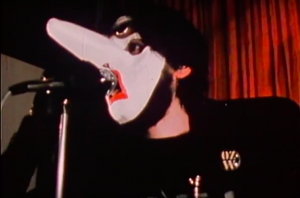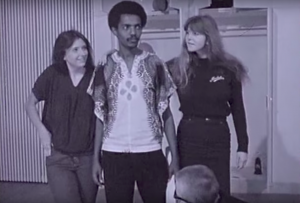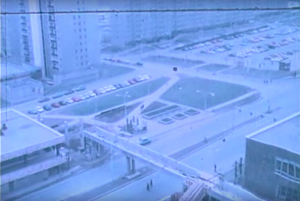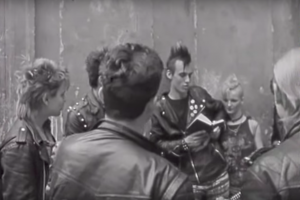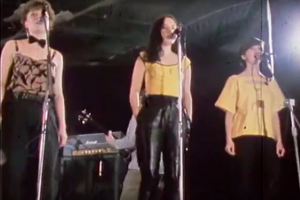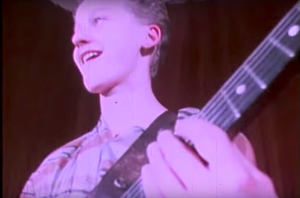HUDBA 85: A snapshot of the Czechoslovak New Wave
From Unearthing The Music
The film Hudba 85 (Music 85) captures the nascent post-punk and New Wave scene in former Czechoslovakia, which was targeted by state-sanctioned media and other actors of the regime (though the bands, in comparison to let's say the Plastic People of the Universe, were hovering on the margins of legality). Shot on 16mm film by friends and amateur filmmakeres Petr Ryba, Alexej Guha and Vladislav Burda, it is an experimental rockumentary presenting the ephemeral state of the scene as it was in 1985, through concert footage and music videos, presented by the aptly nerdy music critic Josef Vlček. Interspersed with abstract meanderings and a well-curated music selection (from reggae Babalet, all-female Dybbuk, or minimal synth band Máma Bubo, etc), Hudba 85 remains a timeless snapshot of the unofficial Czechoslovak music scene of the mid-80s. Here we talk to one of the original authors of the film, Alexej Guha.
Can you talk about what preceded the film Hudba 85? What had you been doing?
Alexej Guha (1957) – direction, production, editing / employed as assistant producer at Czechoslovak TV; Vladislav Burda (1956) part. director / employed as ceramist at national company Dílo; Petr Ryba (1960-2009) part. director, cameraman, editing / employed as janitor at Sady, lesy, zahradnictví hl.m.Prahy/Parks,Woods, Gardening of the Capital City of Prague (alongside other dissidents, though he wasn't a dissident himself). Between 1981-1984 short sketches together or alone; awarded silver for the film „Momentální indispozice Kristýny Bojarové při nedělním obědě v kruhu rodiny“ (The Momentary Indisposition of Kristýna Bojarová During Sunday Family Lunch) together with P. Ryba at the amateur film contest Brno Sixteen.
How would you describe the situation in the early 80s as well as the scene surrounding the bands that you portrayed in the film?
People interested in unofficial culture – literature, music, film, art – would meet at Prague's bars and wine cellars. These circles were not so large. People knew of each other, even those living outside the capital. We were connected with the dissent movement because our friend, the amateur cameraman and photographer, Michal Hýbek, was imprisoned for being involved with the magazine Vokno at the Bory prison where Václav Havel also served a sentence. Even the musicians banned from performing didn't want to just sit at home and, for instance, the Plastic People of the Universe's Mejla Hlavsa began to write songs for the band Garáž.
New Wave as a genre reached Czechoslovakia in the early 80s and several local bands adopted the style until the infamous newspaper article A new wave with an old content, a scathing denigration of the scene, appeared in 1983. From today's standpoint it can be seen as a rather absurd nomenclature critique. Was this article an impetus for the film?
Everyone was rather amused by the article because it was a hodgepodge. It was obvious that it was written by somebody who didn't know the scene too well. Over the course of a few months the bands would change their name (Jasná páka = Hudba Praha; Tomahawk = Hudebně zábavná skupina O.Hejmy…etc) and found a different „grantor“. It meant that instead of Svaz zahrádkářů (The Association of Gardeners) you'd obtain the stamp of approval from another, similar organisation and make new recordings and continued. But to an extent, it could be said that the article had some sort of impact on the film itself because someone had noticed that everyone is back on stage and there were rumours there would be a second round of prohibition. The direct impetus then was that our friends from the band OZW were conscripted for a year and they played their last gig at Motorlet and weren't sure how things would be in a year's time, whether they'd be able to organize a public performance again. And we decided we should film XY and YX before the regime tries to destroy them.
How did you choose which bands to feature in the movie and what was the film's dramaturgy? Hudba 85 remains timeless also thanks to its experimental style, but formally it also precedes the popularity of music shows and rockumentaries.
The choice of the bands was largely based on the programming of two Prague clubs: Opatov Club, booked by journalist Vojtěch Lindaur and Na Chmelnici Club, run by Luboš Schmidtmajer. We discussed our band selection with both of them and somehow divided the selected bands according to personal preferences during the actual filming.
Can you talk about the filming itself? The film combines footage from live gigs, music videos and short introductions by Josef Vlček.
The filming was primarily influenced by then available technology. Mobile video recorders were unavailable in Czechoslovakia at the end of 1984. We shot on two 16mm cameras mostly on expired film material or I'd take film spools from Czechoslovak TV left over from TV reportages (Czechoslovak TV only shot outdoor reportages on 16mm film) that professionals refused to shoot on (when there was lacking information from the laboratory tests, etc). We developed the film under-the-table and paid for it with pottery (coffee and tea sets) made by V.Burda. The filming of the live rendition of a particular track was fairly straightforward: we were only able to insert around 30 metres of material into the cameras we had, which ended up being around 2.5 minutes, while a song would usually last for 3 minutes. Cameramen would agree that one of them would shoot choruses and the other verses, which didn't always work out. Certain parts of songs would be missing, and thus additional shooting became inevitable. Some music videos were intended as such from the beginning (eg Ryba's Máma Bubo). Josef Vlček's comments were set on the backdrop of a derelict building which was supposed to epitomize the state of socialism in our country. Josef had prepared poignant descriptions of the bands, but he'd left his notes at home, so he was sometimes only able to utter „let's have Garáž now“.
Do you have any memories from the filming that stand out?
For instance, when V. Burda had the idea that a person of colour must be dancing in the audience during reggae band Babalet's live show. He went to the student dorms at Strahov (Prague) and ended up convincing someone who ended up joining the band during their live shows as their singer for several years. The best time was after the film was finished and the bands would be coming to watch it in my Prague flat with their partners and friends one by one. We accepted sandwiches and alcohol in the kitchen and then locked them in the living room, secured the windows (there was a hospital across the road, and they would sometimes call the police on us), everyone lit their cigarettes and we listened from the kitchen how they were enjoying the film (there's a Break in the film so that we could get some air).
How do you reflect on the film in retrospect?
Looking back, I see it as a professionally rewarding period that happened outside of our day jobs and in collaboration with people we wanted to meet. While we were putting the finishing touches to the film, Perestroika happened and instead of prohibition, the Socialist Youth Association (SSM) took these bands under its wing and organised the first Rockfest at the Palace of Culture in Prague (where our film would be also shown) in 1986. V. Burda became a fulltime freelance ceramist. P. Ryba was briefly working as a cameraman after 1989, and then built exotic fishbowls (he died in 2009). I produced and directed several music shows until the mid-90s, and as of 1997, I've been working as executive producer of various Czech TV programmes (documentaries, features, music shows). I also direct video reels for exhibitions at the Popmuseum in Prague.
By Lucia Udvardyova, September 2017
